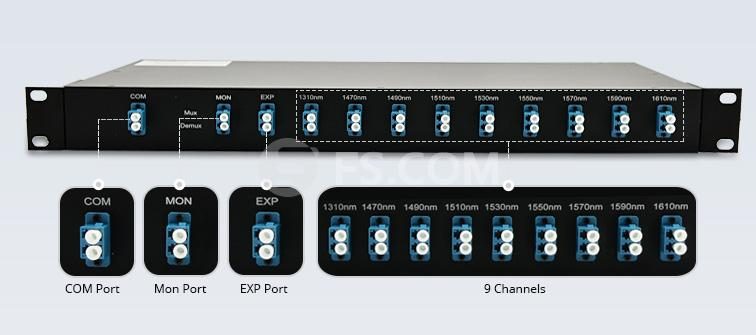In today’s world of intensive communication needs and requirements, fiber optic cabling has become increasingly popular. But considering the physical fiber optic cabling is expensive to implement for each individual service, using a Wavelength Division Multiplexing (WDM) for expanding the capacity of the fiber to carry multiple client interfaces is highly advisable. WDM MUX/DEMUX (Multiplexer/De-Multiplexer) is one of the most important components in WDM systems. But there are so many types of ports which are not so easy to identify. This article will illustrate various ports with different functions on WDM Mux/Demux.
For WDM Mux/Demux, channel port and line port are the most common and necessary ports for normal operation of the WDM Mux/Demux.
Channel Port
CWDM uses 18 wavelengths ranging from 1270nm to 1610nm with channel intervals of 20nm. Channel ports on CWDM MUX/DEMUX is usually ranging from 2 to 18. DWDM uses the wavelength ranging from 1470nm to 1625nm usually with the channel port ranging from 4 to 96. Since DWDM Mux/Demux has a more dense channel spacing of 0.8 nm (100 GHz) or 0.4 nm (50 GHz), it is more suitable for high-density networks.

Line Port
There are two types of line port available for CWDM and DWDM MUX/DEMUX. One is dual fiber line port, and the other is single fiber line port. The wavelengths order and the applications of them are totally different. Dual-fiber line port is used for bidirectional transmission, which means the TX port and RX port of every duplex channel port supporting the same wavelength. The WDM MUX/DEMUXs with dual fiber line ports installed on the two ends of the network could be the same. Single-fiber line port only support one direction data flow. If you choose a single-fiber WDM MUX/DEMUX on one side of the network, there should be a single-fiber WDM MUX/DEMUX which supports the same wavelengths but has the reverse order on the TX port and RX port of every duplex channel port.
1310nm Port and 1550nm Port
1310nm and 1550nm ports are wavelength ports of WDM MUX/DEMUX. Since a lot of optical transceivers use these two wavelengths for long-haul network, adding these two ports when the device does not include these wavelengths is very important. CWDM Mux/Demux can add either type of wavelength ports, but the wavelengths which are 0 to 40 nm higher or lower than 1310 nm or 1550 nm cannot be added to the device. However, DWDM Mux/Demux can only add 1310nm port.
Expansion Port
Expansion port which can be added on both CWDM and DWDM Mux/Demux is a special port to increase the number of available channels carried in the network. It means that when a WDM Mux/Demux can not meet all the wavelength needs, it is necessary to use the expansion port to add different wavelengths by connecting to another WDM Mux/Demux’s line port.
Monitor Port
This port is used to monitor or test the power signal coming out of a Muxed CWDM or before it gets demuxed from the signal coming through the fiber network usually at a 5% or less power level. Generally, it can be connected with measurement or monitoring equipment, such as power meters or network analyzers.
No matter the common ports or the special ports on WDM Mux/Demux have their own features and application. FS.COM WDM products designed for easy and fast implementation take up minimal space and use least power, thus providing the highest integration level of CWDM and DWDM networks. They can also provide complete solutions for CWDM and DWDM. Kindly contact sales@fs.com for more details if you are interested.









